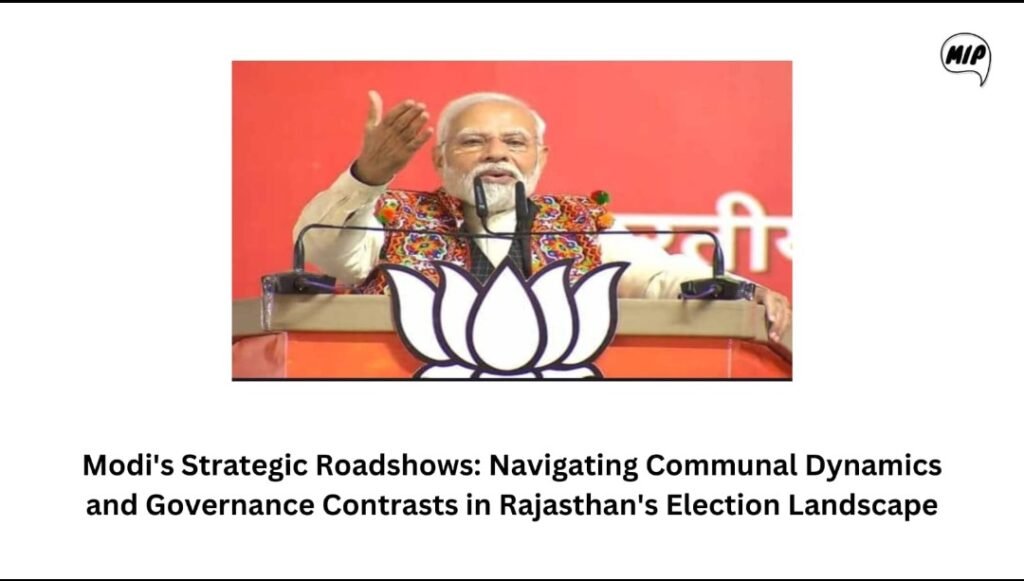
Prime Minister Narendra Modi led the blitzkrieg of the Bharatiya Janata Party in the campaign for the Rajasthan Assembly election. Besides rallies, PM Modi also held his signature roadshows which are now a byword for his bid to send out a final message across poll-bound states through his proximate involvement with people by reaching them in their hometowns.
Going into the election amid the prevailing perception that incumbent Chief Minister Ashok Gehlot had built an impregnable turf in Rajasthan with a slew of schemes, including Chiranjeevi (Rs 25 lakh health coverage), the BJP seemed to be clear that the party’s electioneering baton had to be led by Modi.
Further, BJP’s bid to look beyond the regional satraps in the party made it incumbent upon Modi to shoulder the burden of electioneering. Besides, Modi knows Rajasthan as well as he knows neighbouring Gujarat.
Roadshows To Sharpen BJP Narrative
Modi’s roadshows in Jaipur and Bikaner were strategically executed in line with BJP’s electoral tasks on hand. Roadshows are also a good way to connect to urban voters. Jaipur and Bikaner have for years been communally sensitive. The two regions have even recently reported communal tensions. The demography of the two regions suits the BJP’s trump card of polarisation by amplifying the minority-appeasement plank against the Opposition, particularly the Congress. Rajasthan under the Gehlot administration has seen some communal incidents spread over the regions of Jaipur, Bikaner, and other districts.
Modi’s claim to fame of taking waters from the Narmada project into Rajasthan has, arguably, earned him a place in the hearts of people to this day. The significance of water to Gujarat and Rajasthan which have been historically water parched may not be clear to people from other regions where water resources are abundant.
The Narmada project In Rajasthan involved lifting waters by several metres and building dams to take water to the parched areas through a network of pipelines. The good governance claim of the Gujarat government for years under the BJP dispensation largely hinges on the Narmada project.
Modi had earlier accused the Manmohan Singh-led UPA government of preventing Rajasthan from getting more water from the Narmada. In previous Vasundhara Raje-led governments (2003-08, 2013-2018), Modi had worked closely for the expansion of water availability in Rajasthan through the Narmada project.
Moreover the Lok Sabha verdicts of 2014 and 2019 in Rajasthan when BJP swept the state give ample evidence of the massive appeal that the Prime Minister enjoys among the people of the state.
Countering Gehlot’s Welfarism
The Rajasthan assembly election is special for the contrasting governance models of Modi and the Congress. Modi’s welfarism is targeted, and with scope for excluding the affluent (recall the Give it Up campaign). In contrast, the Congress espouses universal coverage for welfare schemes as illustrated by parliamentary enactment for food security, rural unemployment, etc.
The Congress party’s national leadership and the Gehlot government are in agreement on unveiling a slew of schemes which aim to give a perception that the state will take care of the basic concerns of the people. But BJP believes that the Congress model is a conduit for pervasive corruption.
To press this point, Modi unleashed the “Red Diary” attack on the Gehlot government. Modi has pitched his development model as one that will uplift and care for the vulnerable sections. In contrast to the allegations of corruption against Gehlot and his government, the BJP claims an incorruptible image for the PM and promises to work in the same mould as him. This has made Modi’s Rajasthan campaign crucial for the BJP.